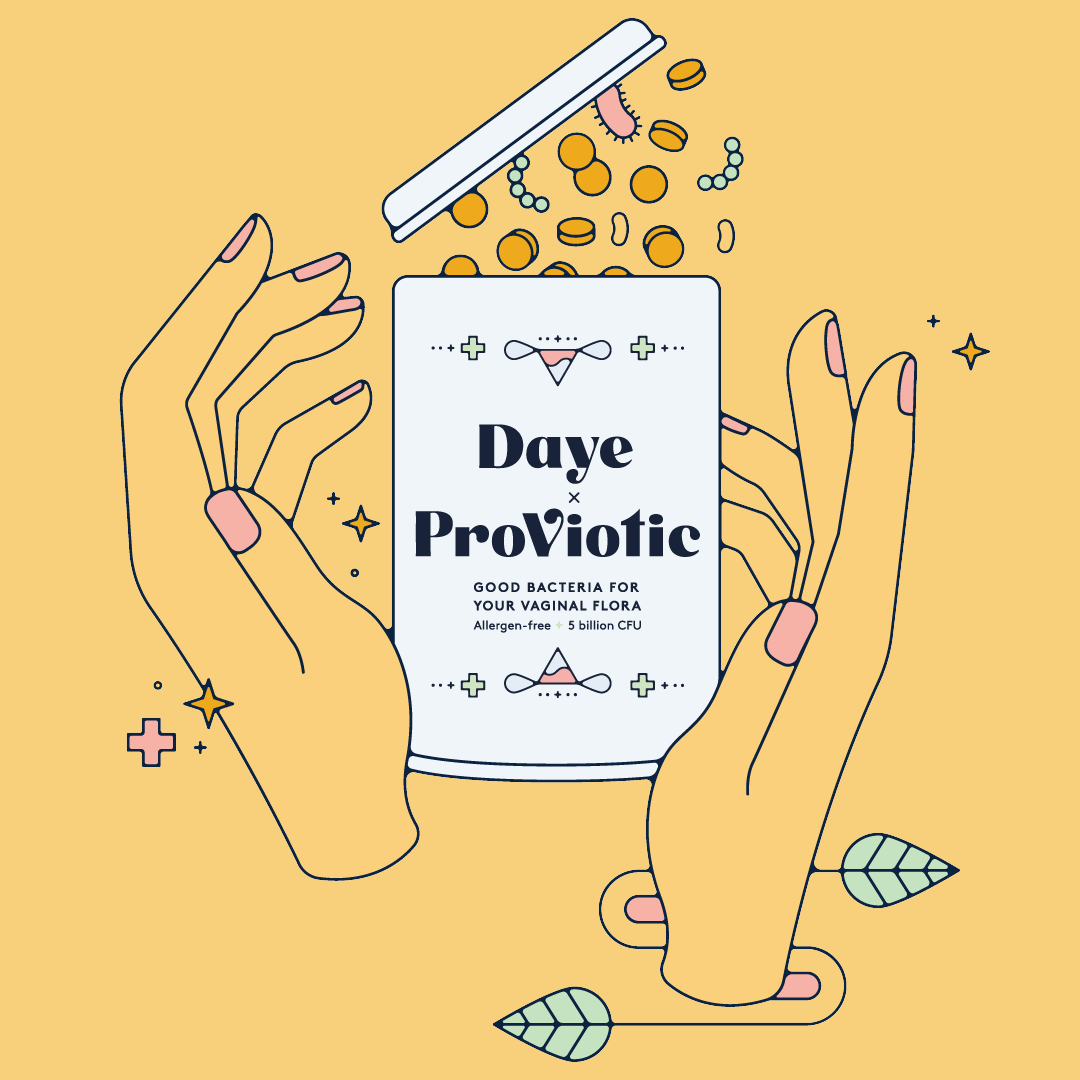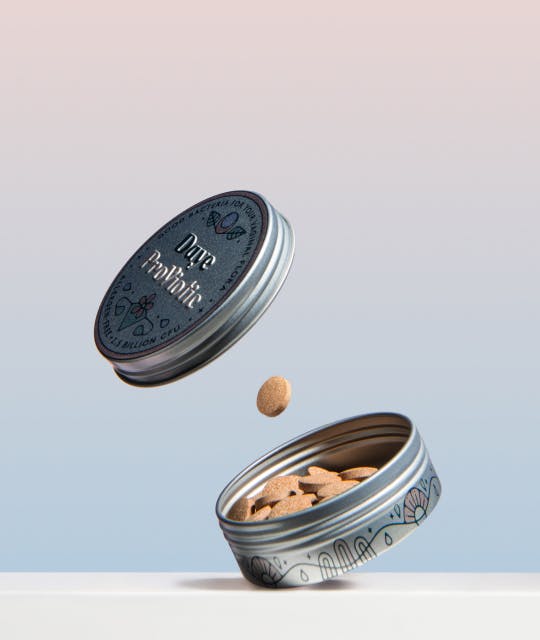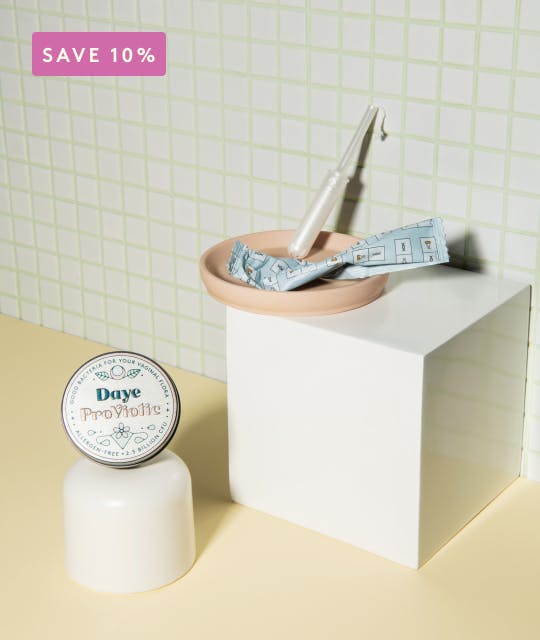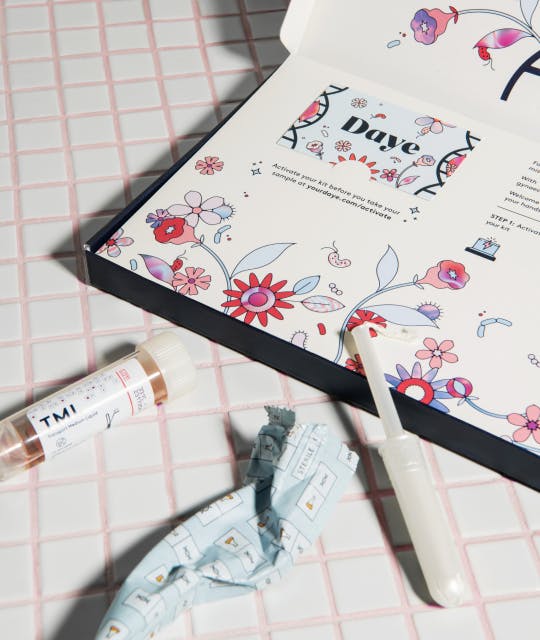Table of contents
1. Lactobacilli - your vagina's very own immune system
2. How probiotics reduce the risk of vaginal infections
3. The gut-vagina connection
4. L. plantarum GLP3 - our powerhouse probiotic strain
5. How we make ProViotics
6. Are probiotics safe?
7. Single-strain vs. multi-strain probiotics: why more isn’t always better
8. Efficacy of Daye's ProViotics
9. Wrapping it up
Written by Kalina Mihaylova
Illustrated by Maria Papazova
Let's talk vaginal health. As science dives deeper into the world of microbiomes, probiotics have emerged as key players in supporting overall wellbeing. And guess what? They're not just for your gut anymore. These beneficial bacteria are making waves in vaginal health too.
Lactobacilli - your vagina's very own immune system
Think of lactobacilli as your vagina's built-in security system. These lactic acid-producing bacteria are the most common residents in a healthy vagina. They adhere to the vaginal walls, creating a protective barrier against unwanted pathogens. Plus, they're constantly producing lactic acid and other antimicrobial substances, making life difficult for harmful microorganisms.
While your vagina naturally hosts lactobacilli, research shows that adding more to the mix can significantly boost your vaginal health.
How probiotics reduce the risk of vaginal infections
Probiotics can help reduce the risk of vaginal infections through several mechanisms:
- Competitive exclusion - Beneficial bacteria occupy space and resources, making it harder for harmful microbes to attach themselves to the vaginal wall.
- pH regulation - Lactobacilli produce lactic acid, maintaining an acidic vaginal environment that prevents the growth of many pathogens.
- Production of antimicrobial compounds - Some probiotic strains produce substances that directly kill or inhibit harmful microorganisms.
While these mechanisms are powerful, the effectiveness of probiotics can vary from person to person, and it's not always immediately apparent if they're working. Generally, it takes about 8 to 12 weeks of consistent daily use of oral tablets to start noticing benefits. Some signs that your probiotics are working may include a reduction in vaginal discomfort, less frequent infections, or a decrease in abnormal discharge.
However, many of the positive effects happen at a microscopic level and may not be immediately noticeable. That's where microbiome screening comes in. At Daye, we offer Vaginal Microbiome Testing that can provide a clear picture of your lactobacilli levels before and after probiotic use. This approach allows you to objectively track changes in your vaginal microbiome over time.
We recommend doing an initial test before starting probiotics use, followed by another test after 2 to 3 months of use. This before-and-after comparison can provide valuable insights into how your vaginal microbiome is responding to the probiotic treatment.
Remember, everyone's body is different, so the timeline and extent of changes can vary. Consistent use and regular monitoring are key to understanding how probiotics are working for you.
The gut-vagina connection
Interestingly, oral probiotic supplements can benefit vaginal health through the gut-vagina axis. When ingested, probiotics colonise the gut and can then migrate to the vaginal area. This migration occurs through a process called bacterial translocation, where bacteria from the rectum can travel to the vagina. Additionally, a healthy gut microbiome supports overall immune function, indirectly benefiting vaginal health.
L. plantarum GLP3 - our powerhouse probiotic strain
Meet Lactobacillus plantarum GLP3, the hero of our ProViotics. This strain has been rigorously tested and proven to be a champion of vaginal health. It's excellent at keeping harmful bacteria in check and maintaining that all-important vaginal pH balance.
Clinical studies have evaluated the effectiveness and tolerability of orally-delivered probiotics containing Lactobacillus plantarum in promoting the colonisation of beneficial lactobacilli in the vaginal walls. Results demonstrated that probiotic intake significantly improved lactobacilli colonisation, leading to improvements in clinical signs such as redness, swelling, and discharge. These findings suggest a potential therapeutic role for Lactobacillus plantarum in preventing recurrent vulvovaginal candidiasis, also known as thrush.
Another study explored the influence of lactobacilli on the resistance of Candida yeasts to fluconazole, the main treatment for thrush. Among the 153 lactic acid bacteria strains examined, Lactobacillus plantarum stood out with its ability to enhance the susceptibility of Candida yeasts to the antifungal medication. This suggests that L. plantarum may reduce the resistance of Candida albicans, potentially increasing the effectiveness of fluconazole treatment in vaginal thrush.
How we make ProViotics
We grow our L. plantarum GLP3 in nutrient-rich carrot juice. Why? Because this medium fosters the growth of a potent and robust strain, making it more effective compared to traditionally fermented probiotics. Our unique cultivation process ensures a high concentration of live, active bacteria.
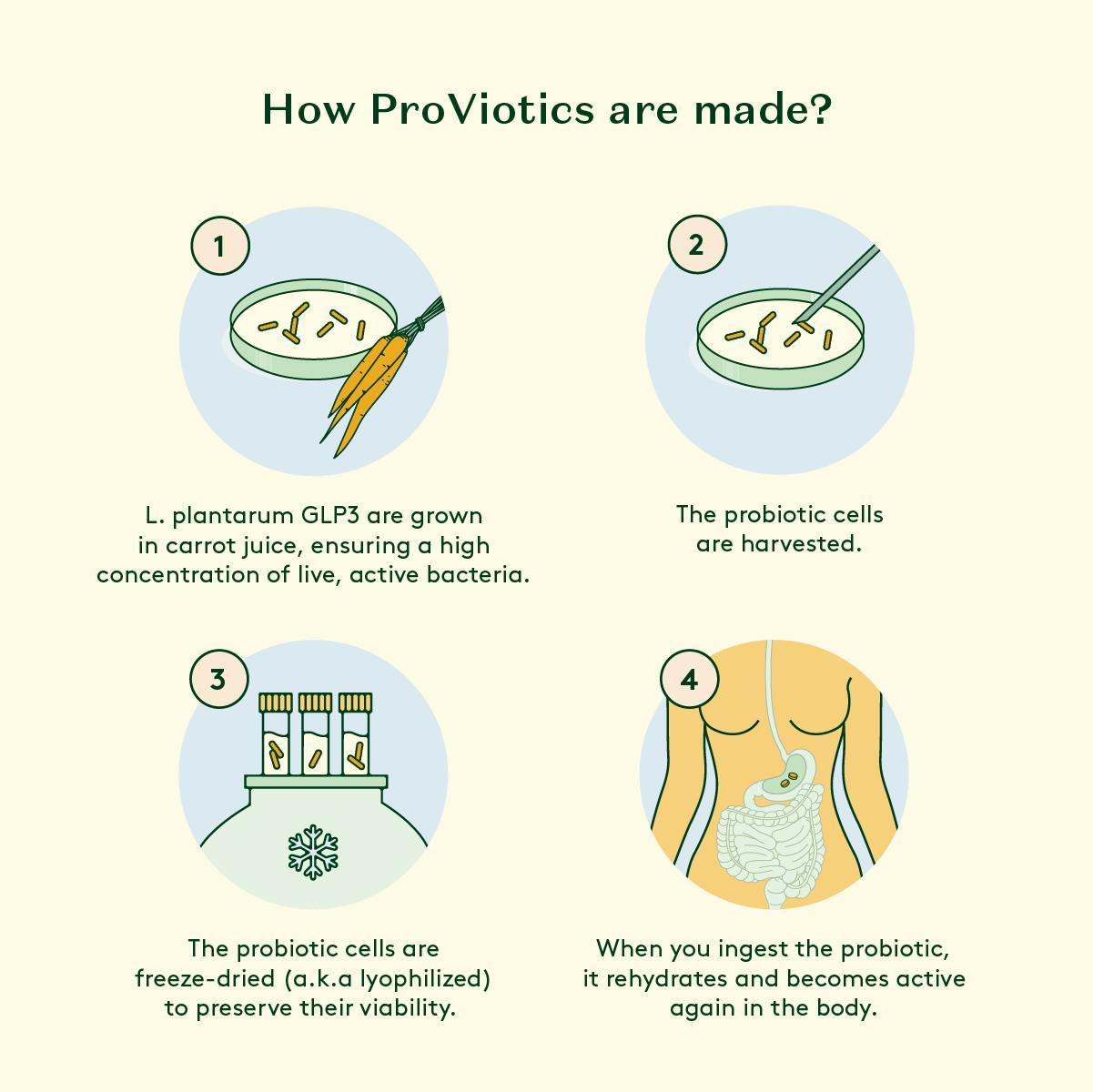
The probiotic cells are then carefully harvested and freeze-dried to preserve their viability. This process, known as lyophilization, removes water from the bacterial cells, putting them into a dormant state. When these freeze-dried probiotics are ingested, they rehydrate and become active again in the body.
Are probiotics safe?
Probiotics have a long-standing history of safe use, dating back centuries. This extensive track record has earned them "grandfather" status in terms of safety. Lactic acid bacteria, including Lactobacillus species, have been consumed by humans for thousands of years through fermented foods like yogurt, kefir, and sauerkraut. This long-term consumption without significant adverse effects has led regulatory bodies like the U.S. Food and Drug Administration (FDA) to classify many probiotic strains as "Generally Recognized as Safe" (GRAS). The European Food Safety Authority (EFSA) has also granted "Qualified Presumption of Safety" (QPS) status to many Lactobacillus species. This established safety profile, combined with the growing body of scientific evidence supporting their benefits, makes probiotics a trusted option for promoting vaginal health.
At Daye, we've taken this commitment to safety a step further. Our ProViotics come in tablet form without any additives, fillers, or unnecessary ingredients. This clean formulation not only aligns with the established safety profile of probiotics but also offers several additional advantages:
- With no added substances, you're getting only the beneficial probiotic bacteria, maximising the potential health benefits.
- Eliminating additives reduces the chance of adverse reactions, especially for those with sensitivities, further enhancing the safety profile of our product.
- Our additive-free tablets are appropriate for vegans, vegetarians, and those with specific dietary restrictions, making vaginal health accessible to a wider range of individuals.
- Fewer ingredients mean a smaller environmental footprint in production and packaging, aligning with our commitment to both personal and planetary health.
Single-strain vs. multi-strain probiotics: why more isn’t always better
While it might seem intuitive that a probiotic with multiple strains would be more effective, research suggests this isn't always the case. In fact, combining different probiotic strains can sometimes lead to decreased efficacy. While it might seem intuitive that a probiotic with multiple strains would be more effective, research suggests this isn't always the case. In fact, combining different probiotic strains can sometimes lead to decreased efficacy. Here's why:
1. Competition for Resources & Space
Different bacterial strains often compete for the same nutrients and energy sources. In a multi-strain formulation, this competition begins in the product itself and continues in the body. This can lead to some strains outcompeting others, potentially reducing the overall effectiveness of the probiotic.
Moreover, probiotics need to adhere to the gut or vaginal lining to colonise and exert their beneficial effects. When multiple strains are present, they may compete for these limited attachment sites. Some strains may be more efficient at adhering, preventing other potentially beneficial strains from establishing themselves.
2. Mutual Destruction
Many probiotic strains produce antimicrobial substances as part of their protective mechanism. While these compounds are beneficial in fighting harmful bacteria, they can also inhibit the growth of other probiotic strains. In a multi-strain product, some bacteria might inadvertently suppress the growth of their fellow beneficial bacteria.
3. Different Optimal Conditions
Each bacterial strain has its own ideal conditions for survival and growth. These can include specific pH levels, nutrient requirements, and environmental factors. A product formulated to accommodate multiple strains might not provide optimal conditions for any single strain, potentially reducing their overall effectiveness.
Efficacy of Daye's ProViotics
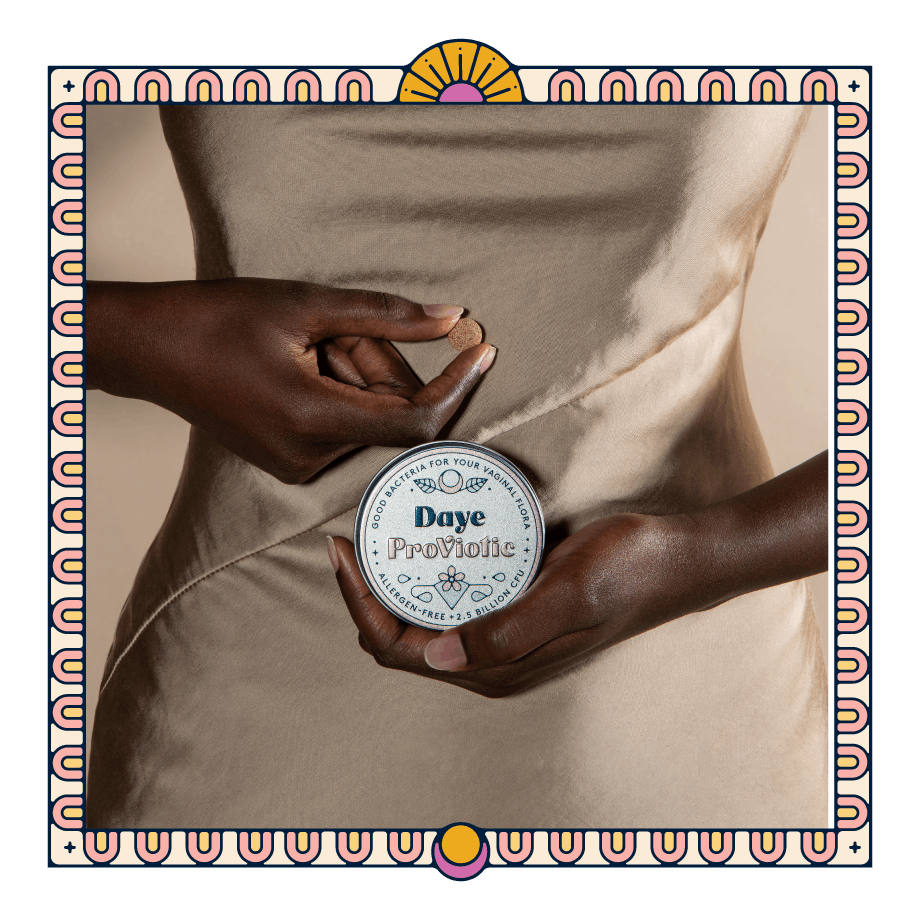
We've conducted several studies to understand how our probiotic, Lactobacillus plantarum GLP3, behaves in different environments and to ensure its safety. Here's what we found out:
1. How well does it grow in a vaginal environment?
What we did: We compared how our probiotic grows compared to other probiotics (Brand 1 and Brand 2) and a common gut bacteria (E. coli) in four different environments:
- A standard lab broth (LB)
- A special broth designed for growing probiotics (MRS)
- A simple nutrient solution (MM9)
- A solution that mimics vaginal fluid (SVF)
We started with the same amount of bacteria in each environment and watched how they grew and changed the acidity over five days.
What we found:
- In the fake vaginal fluid, our probiotic grew twice as much as the other probiotics.
- While other probiotics made this environment more acidic, ours didn't change the acidity much.
- In the probiotic-friendly broth (MRS), all probiotics grew well and made it more acidic.
- In the simple nutrient solution, only one of the other probiotics (Brand 1) grew well.
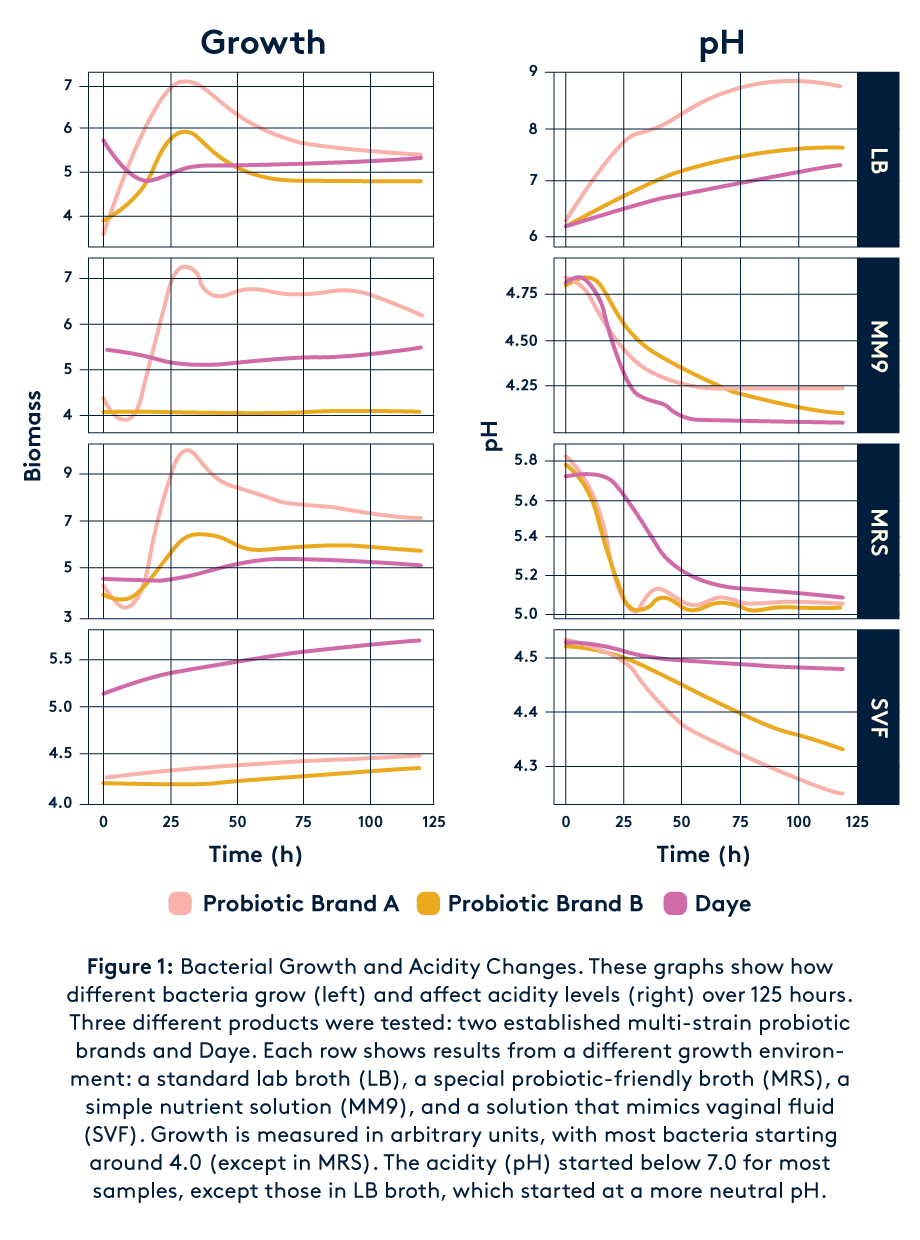
Why it matters: A probiotic that can grow well in the vagina without disrupting its natural acidity is more likely to be effective at promoting vaginal health. Our probiotic showed it can do this better than others.
2. Is It Safe to Use with Antibiotics?
What we did: We tested how our probiotic, Lactobacillus plantarum GLP3, responds to different antibiotics. This is important because some bacteria can become resistant to antibiotics, which is a global health concern. We used a method recommended by the European Food Safety Authority (EFSA) to measure the minimum amount of each antibiotic needed to stop our probiotic from growing.
What we found:
- Our probiotic is sensitive to all the antibiotics we tested. This means even small amounts of these antibiotics can stop it from growing.
- For example, it only took 0.75 mg/L of ampicillin to stop our probiotic, while the safety limit set by EFSA is 2 mg/L.
- Similarly, for erythromycin, it only took 0.38 mg/L, well below the EFSA limit of 1 mg/L.
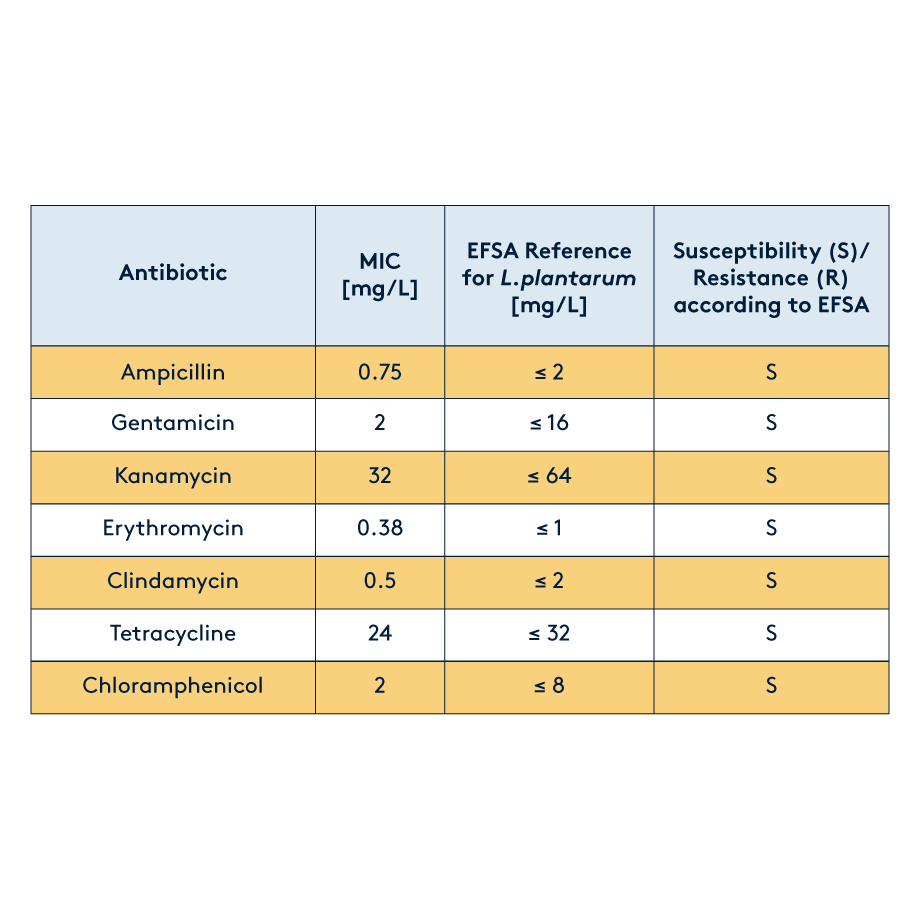
Why it matters: Antibiotic resistance is a serious global health issue. When probiotics are resistant to antibiotics, they could potentially pass this resistance on to harmful bacteria, making infections harder to treat. Our results show that Lactobacillus plantarum GLP3 is sensitive to common antibiotics, which means:
- It's safe to use alongside antibiotic treatments if needed.
- There's no risk of it contributing to antibiotic resistance.
- It meets important safety standards set by European health authorities.
This makes our ProViotics a safe choice for supporting your vaginal and gut health, without compromising the effectiveness of antibiotics if you ever need them.
3. Can It Handle the Acidity of the Gut & Vagina?
What we did: We tested how well our probiotic, Lactobacillus plantarum GLP3, survives and grows in different levels of acidity. We grew the bacteria in lab conditions that mimic the acidity levels found in different parts of the digestive system: very acidic (pH 2.0, like the stomach), neutral (pH 6.0, our control), and slightly alkaline (pH 8.0, like parts of the intestine). We then counted how many bacteria survived over a 3-hour period.
What we found:
- In very acidic conditions (pH 2.0), our probiotic maintained a stable population, though lower than in neutral conditions.
- In slightly alkaline conditions (pH 8.0), our probiotic grew just as well as in neutral conditions.
- Our probiotic not only survived but actually increased its population in both acidic and alkaline environments over the 3-hour period.
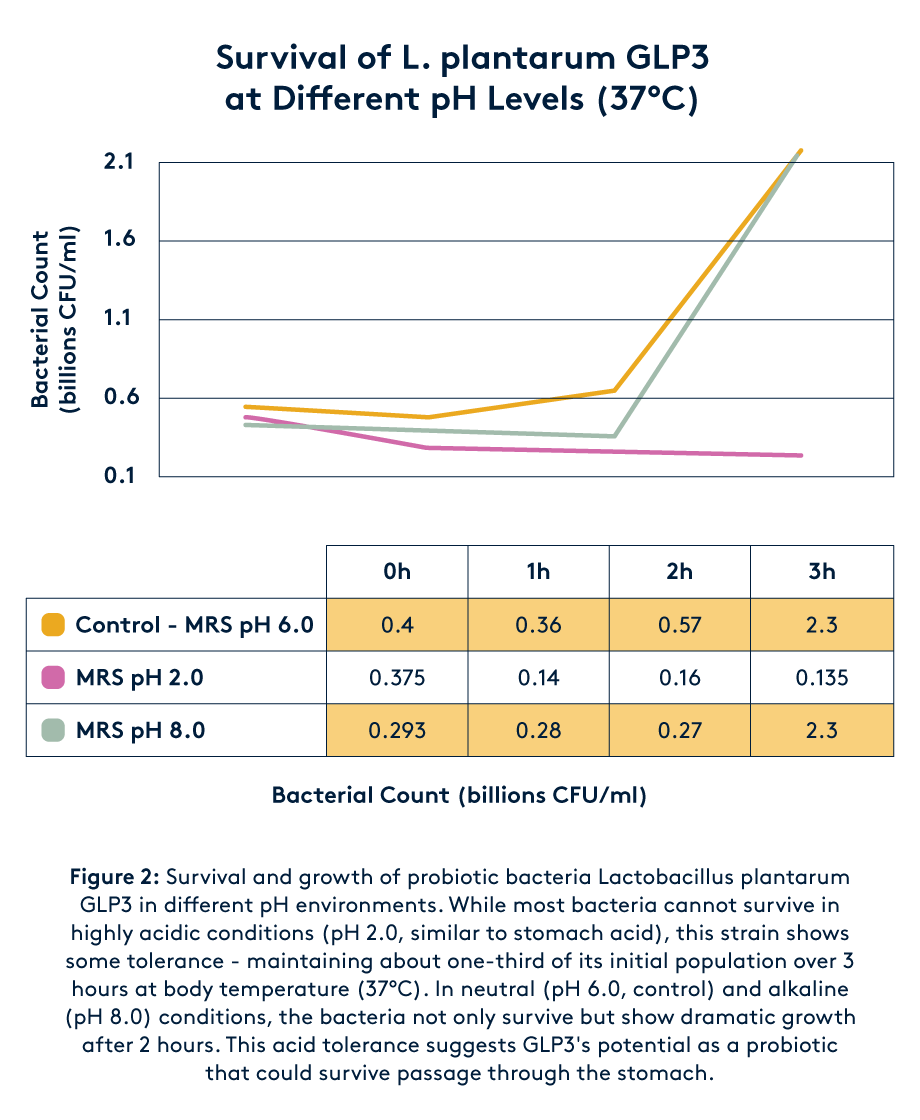
Why it matters: For a probiotic to be effective, it needs to survive the journey through your digestive system, which includes very acidic environments like the stomach. The vagina is also naturally acidic, with a pH typically between 3.8 and 4.5. Our results suggest that Lactobacillus plantarum GLP3 can survive and even thrive in these acidic conditions, making it a promising candidate for both gut and vaginal health. This resilience to different pH levels indicates that our probiotic is likely to reach its target destination - whether that's your gut or your vagina - alive and active, ready to provide its beneficial effects.
4. Can ProViotics prevent UTI- & vaginitis-causing bacteria from growing?
What we did: We tested how well our probiotic, Lactobacillus plantarum GLP3, can fight against harmful bacteria in lab conditions. We mixed our probiotic with various disease-causing bacteria in liquid samples and observed what happened over 48 hours. The harmful bacteria we tested included those commonly associated with different diseases, such as Listeria monocytogenes, Escherichia coli, Salmonella typhimurium, Clostridium perfringens, Bacillus subtilis, Cutibacterium acnes, and Staphylococcus aureus.
What we found:
- Our probiotic significantly reduced the growth of all the harmful bacteria we tested.
- In all cases, the reduction in the numbers of "bad" bacteria was greater than 95%.
- For some harmful bacteria, like Staphylococcus aureus, Escherichia coli, and Enterobacter aerogenes, our probiotic completely stopped their growth (100% inhibition).
- Even for the toughest bacteria in our test, Clostridium perfringens, our probiotic still managed to reduce its growth by 95.3%.
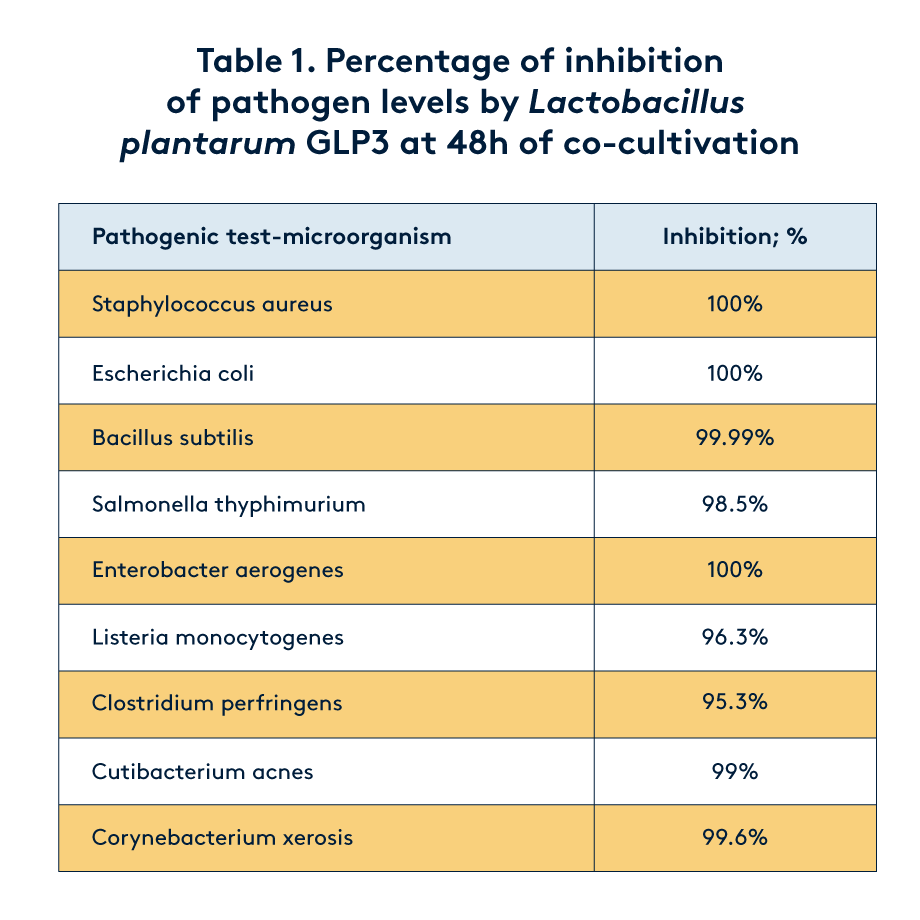
Why it matters: The ability of a probiotic to fight against harmful bacteria is crucial for maintaining health, both in the gut and in other areas of the body like the vagina. What's particularly exciting about our results is that Lactobacillus plantarum GLP3 showed broad-spectrum activity, meaning it was effective against a wide range of different harmful bacteria. This is unusual for a Lactobacillus species and suggests that our probiotic has unique properties that make it especially good at fighting off various types of harmful bacteria. This broad-spectrum activity could make our probiotic particularly effective at maintaining a healthy balance of bacteria in the body and protecting against various types of infections.
5. How Effective Is Our ProViotics Against Vaginal Thrush?
What we did: We conducted a small trial with 29 women who had vaginal thrush, a common yeast infection caused by Candida albicans. Each of the participants used our probiotic directly in the vagina every day for 10 days. Each daily dose contained 5.1 billion live bacteria (Lactobacillus plantarum GLP3).
What we found:
- After 10 days, 28 out of 29 women (97%) no longer had any detectable Candida albicans in their vaginas.
- These 28 women also reported significant improvement in their symptoms.
Why it matters: These results suggest our probiotic could be very effective at treating vaginal thrush. A 97% success rate is promising, especially for a condition that often comes back even after treatment with conventional antifungal medications.
While further studies are necessary to investigate long-term efficacy in larger populations, the data suggests that the Lactobacillus plantarum GLP3 contained in Daye's ProViotics shows promising effectiveness in restoring vaginal health, as supported by pre-existing evidence.
Wrapping it up
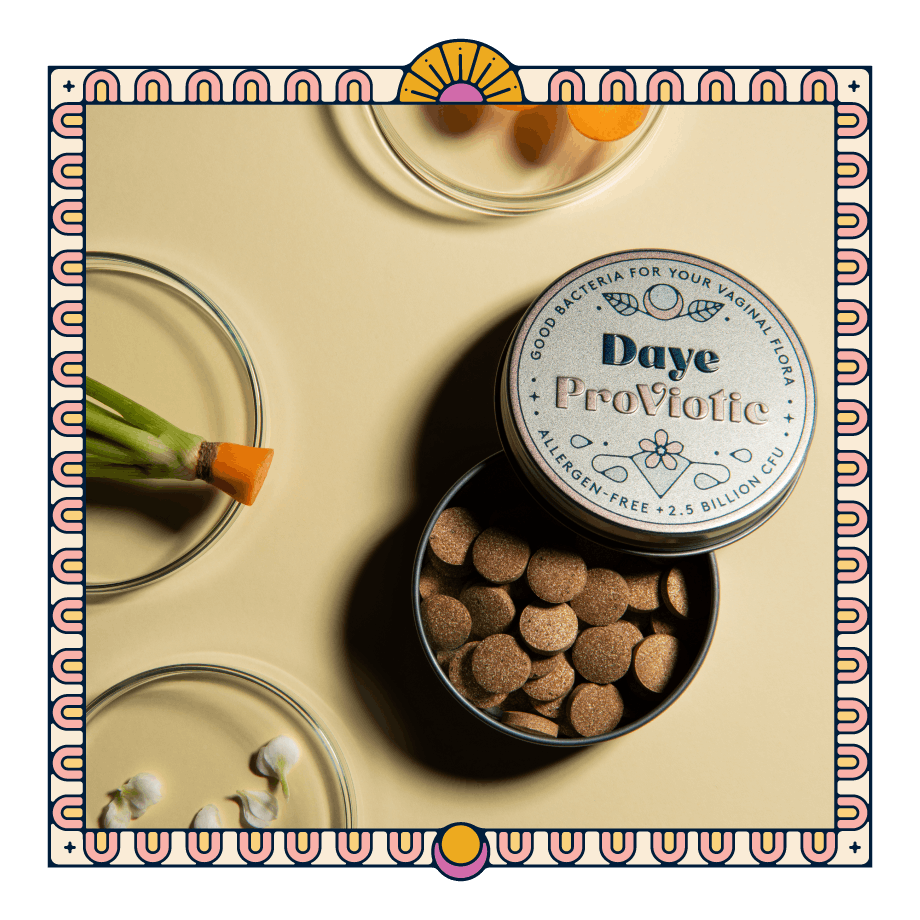
While we're excited about these results, we're not stopping here. Our commitment to changing the way we manage vaginal health drives us to continually research, innovate, and improve. We believe in empowering you with not just products, but knowledge - because understanding your body is the first step to taking control of your health.
If you are considering giving probiotic a try, remember that:
- Consistency is key. Daily use for 60 to 90 days is generally how long it’s needed for lactobacilli to colonise your digestive and vaginal tracts. Add it to your morning routine or keep them next to your bed until the habit sticks.
- Remember that every body is unique. What works for one person may not work the same for another.
- Probiotic use should be considered as part of a holistic approach to health, including proper hygiene, balanced diet, and regular medical check-ups.
- Always consult with a healthcare provider before starting any new supplement regimen if you have ongoing health concerns or are pregnant.
Contrary to common belief, achieving optimal vaginal health is a marathon, not a sprint—and probiotics can be an essential part of the journey. If you're unsure where to begin, you can now schedule a 1:1 consultation with one of our Vaginal Microbiome experts, who will provide you with a detailed, personalised action plan to address your needs.
Related Products
See our Founder’s results!
Wondering what we test for, and what results look like? Enter your email below and Valentina, our Founder, will send you her screening report.
By entering your email above you agree to receive marketing emails and promotions from Daye.
Sources
New evidence on oral L. plantarum P17630 product in women with history of recurrent vulvovaginal candidiasis (RVVC): a randomized double-blind placebo-controlled study
R. VLADAREANU, D. MIHU, M. MITRAN, C. MEHEDINTU, A. BOIANGIU, M. MANOLACHE, S. VLADAREANU
Phenotypic and genotypic assessment of Lactobacillus plantarum influence on Candida albicans fluconazole resistance
Ionela Sarbu, Tatiana Vassu, Ileana Stoica, Luminita Dascalu, Carmen Chifiriuc, Diana Pelinescu
https://annalsmicrobiology.biomedcentral.com/articles/10.1007/s13213-015-1159-1#Bib1



